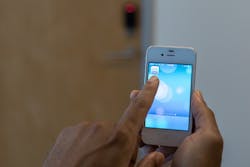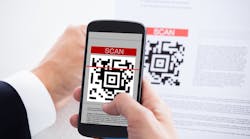After attending my first Consumer Electronics Show (CES) in January, it has become clearer than ever the inevitable crossover that consumer technologies will have with the security industry. And no innovation has been more ubiquitous on the CES floor in recent years than mobile technology.
It didn’t take long for our industry to feel the proverbial shockwaves. Nearly every technology that will appear on the ISC West show floor in April will come with an accompanying mobile app. Why? Because all of you — security dealers and integrators, and even your end-user clients — are consumers; the vast majority of whom already know how convenient it is to be “connected.”
The numbers don’t lie. According to the Pew Research Center, as of Jan. 2014, 90 percent of American adults had a cell phone and 58 percent of them owned a smartphone — a growth rate of 25 percent in a single year.
“It’s a natural evolution,” says Kavi Turnbull, COO of iCrimeFighter, a provider of mobile forensics and evidence gathering software for law enforcement applications. “The more familiar people are with a technology in their everyday lives, the more they seek out how to use that technology in their work lives.”
Need more proof? Look no further than the government. MorphoTrust is currently piloting a program to create an electronic identification (eID) for citizens in North Carolina to be able to use for online transactions that would normally have to be conducted in-person at a state office (read more at www.securityinfowatch.com/12042812).
According to CA Technologies, the increased focus on the mobile phone or mobile device being used as a universal authenticator can be traced to factors such as President Obama’s executive order (for multi-factor authentication), chip and PIN / signature technology, biometrics and new payment models that will drive demand for simpler and streamlined authentication.
For security dealers and integrators, mobile technology is having an impact on just about every aspect of the business. Customers —both commercial and residential — are asking for features that enable them to access their systems from anywhere. Integration and sales opportunities abound in upgrade prospects from market to market. And perhaps most interestingly, mobile technology is clearing the path to greater profits by creating installation and sales team efficiencies and limiting truck rolls.
As mobile comes of age in the security industry, it’s an exciting time. Here’s how mobile is impacting different technologies, markets and more:
Access Control
Perhaps the leader in embracing mobile technologies to radically change the way the technology is used, the access control industry has been on the mobile cutting edge for some time.
“One of the keys to success over the next several years will be to have an offering beyond traditional access control readers, panels, cards and software and embrace the new position of the industry which includes things such as remote management, mobile and fixed functionality credentials and wireless, reducing administrative burden and increased efficiency and integration with human capital management software,” says Blake Kozak of research firm IHS Inc. “Mobile solutions, including secure IDs and a simple yet comprehensive lifecycle management process, are a critical success prerequisite. With the advent of mobile solutions, the access control industry of tomorrow is knocking at the door.”
2014 saw Apple announce the new iPhone 6 and iPhone 6 Plus, which feature a near field communications (NFC) antenna design. Many access control experts saw this as a major milestone — as many thought that NFC had not gained the traction because of a lack of NFC compatibility with iPhones. “I think it is really going to impact the market overall in the sense that more and more end-users will start using (NFC),” Kozak says.
Jeremy Earles, readers and credentials portfolio manager for Allegion, believes the NFC capabilities in iPhones will help boost adoption of NFC to the mass market for all uses of the technology, including access control. “Because iPhone users make up a large portion of the smartphone market in the U.S., any technology Apple incorporates into its products will likely influence user behavior and adoption rates,” he says. “We hope that leads to an increase in overall use of NFC mobile access control options.”
“This past year laid the foundation for what we expect to be an exciting 2015 for our customers and partners,” says Dr. Selva Selvaratnam, senior vice president and chief technology officer with HID Global. “Whether it is moving campus IDs onto smartphones, or centralizing all identity management for protecting doors, data and cloud-based applications, or securing electronic medical prescriptions and ATM transactions, we will see the transformation of our customers’ experience using secure identities during the coming year and beyond,” he concludes.
Mobile access control on smartphones will enable a more hassle-free security experience for users, who can carry all of their keys and credentials on a device they carefully protect and rarely lose. In fact, according to HID’s John Fenske, one of the most attractive opportunities for access control solutions on mobile devices involves the use of Bluetooth Smart connections and gesture technology, which enables users to open doors from a distance by rotating their smartphone as they approach a mobile-enabled reader. “Gesture-based access control will also increase speed, and minimize the possibility of a rogue device surreptitiously stealing the user’s credential in a ‘bump and clone’ attack,” Fenske adds in his full article, available at www.securityinfowatch.com/12014596.
Hotels and resorts have become one of the leading “test markets” for mobile access control solutions. In July 2014, Hilton Worldwide, which operates more than 4,000 hotel and timeshare properties in 93 countries around the world, announced that that it would allow guests to use their smartphones as room keys as part of its new digital strategy. In fact, the company said in a statement that guests will be able to use their smartphone as their room key in majority of hotel rooms by 2016 — that’s more than 650,000 hotel rooms worldwide.
“The smartphone access control business, from our perspective, is growing nicely,” Paul Bodell, president and CEO of ECKey, told Joel Griffin of SecurityInfoWatch.com (read more at www.securityinfowatch.com/11621636). “Any time an end-user acknowledges that cards are antiquated… it is beneficial to our business and the smartphone access control industry as a whole.”
Adds Terry Gold, founder of IDanalyst, a vendor-neutral research and advisory firm focused on security, identity and privacy: “At the end of the day, we all know mobile is where (the market) is going. Each of us wants everything on our mobile device. I think Hilton’s announcement just further validates that large organizations agree with that and they see the same thing from their consumers. It validates the culture, the demand and the direction.”
Video Surveillance
The mobile market in the video surveillance industry may be a bit more cut-and-dry than in access control. Simply, users want to be able to access their camera feeds using their mobile devices. Still, this revelation is causing a major impact — especially among small and medium businesses that previously may not have seen the ROI or value in a full IP surveillance system.
“Small system users value flexibility and ease of use, and with these new mobile apps, users have even more flexibility with remote access to their high-definition surveillance video right from their mobile devices,” says Ryan Gregory, systems and solutions manager for business development with Axis Communications. “These new in-house developed mobile apps not only assure optimal performance and compatibility, but also give our customers the tools they need to efficiently secure their operation wherever they are.”
Of course, VMS providers have also eagerly jumped on the mobile bandwagon. Mobile VMS solutions enable security personnel to perform live monitoring or synchronized playback of multiple HD cameras from a tablet, smartphone or any web interface. “Integrators must provide their customers with the technology to move out of the control room and into the field without sacrificing functionality,” explains Gadi Prian, president of OnSSI. “This is what the current population of technology consumers expects in every area of life and of business, and providers who do not make this utility possible will find themselves left behind.”
Residential Security
It makes sense that many mobile technologies both developed and took hold in the residential market, as consumer demand has dictated. The smart home revolution — which of course is having a profound impact on the residential security market — is leading the drive of mobility into the home.
According to research firm Berg Insight, the number smart homes in Europe and North America reached 10.6 million in 2014, with the North American market recording a 70 percent year-on-year growth in the installed base of smart homes — to 7.9 million at the end of the year.
The number of North American and European homes with a smart thermostat grew by 105 percent to 3.2 million in 2014, with the North American installed base of smart thermostats rising to 2.5 million. The strong market growth is expected to last for years to come, driving the number of smart homes in North America to 38.2 million by 2019, which corresponds to 28 percent of all households.
In addition to smart thermostats, the most successful products in the smart home market include security/alarm systems, smart light bulbs, network cameras and multi-room audio systems. This has prompted some of the largest residential security vendors to join the fray. Honeywell was the most recent, announcing its first full connected home product line at the aforementioned CES.
NFC has also found its way into the smart home, with Yale recently announcing an NFC-capable residential lock. And products like D-Link’s Wi-Fi Smart Plug can turn plug-in home lights, appliances, game systems and more into items that can be controlled with the swipe of a finger.
Another area of residential security experiencing exponential growth is in mobile PERS devices. “By extending protection services to subscribers and their families when they are out of their homes at school, work or out enjoying themselves, security companies can practically guarantee increased RMR and lowered attrition rates,” explains Barry Schweiger, co-founder of SmartTek, which offers smartphone-based security services such as mPERS that integrate directly with a central station. “We see this as a very strong closing tool for dealers.”
Dealers will have the opportunity to sell the SmartTek apps as a stand-alone product or bundle it with other alarm and smart home-based services.
Sales and Installation
Vendors are also sensitive to the growing needs of dealers/integrators when it comes to making sales and installing systems. Need help laying out a camera system? Chances are your video surveillance vendor partner has an app to help you out. The Eagle Eye Viewer app from Eagle Eye Networks is just one example of how video vendors are eliminating the laptop computer from installations. “The mobile app makes setting up cameras and deploying the VMS even simpler,” says CEO Dean Drako.
Want to demo a security and lifestyle system for a potential residential buyer? No problem. “Apps like (Honeywell’s LYNX Touch 5200 and 7000 home security system demos) will help dealers demonstrate to customers the power of the ‘Connected Home’ and how it will enhance their everyday lives, as well as their security,” explains Alan Stoddard, senior marketing director, Honeywell Security Products Americas.
Even distributors have gotten into the act. ADI, for example, released a mobile app in July 2014 that dealers can use to check product pricing and availability, and place orders for pick up or delivery with ease. “As mobile activities continue to increase across the industry, developing a mobile app was a priority for us to better serve our customers while they are on the road,” explains Michael Flink, president of ADI.
In the end, the message is clear: mobile apps are changing the face of the world — the security industry is just living in it. Expect more at a faster pace in 2015 and beyond.
Paul Rothman is Editor-in-Chief of SD&I magazine (www.secdealer.com).
Sidebar
Mobility Delivers ROI
Restaurant operator realizes the benefits of all-access VMS technology
The parent company in New Zealand for KFC, Pizza Hut, Carl’s Jr and Starbucks has installed Milestone XProtect video management software (VMS) throughout its chain of restaurants. The system’s mobile capabilities have proven to be a major source of ROI.
“The solution has made day-to-day operations much easier,” explains Geoff Holton, Commercial IT Manager at Restaurant Brands Limited (RBD). “Prior to this, managers were only able visit one or two stores at a time, but now they look remotely at the foyer area of their stores using the XProtect Smart Client interface.”
Loss prevention was improved by monitoring the different food preparation processes at the restaurants and managing waste levels. Theft was lowered among both dishonest customers and staff. Simultaneously, staff safety increased and more efficient day-to-day operations became the norm.
Managers can remotely see how many customers each branch has, how many cash registers are open and how many employees are operating the counters. The software also helps them keep track of peak hours and check the restaurants’ performance during these hours.
“Both IT management and supervisors can remotely check on the stores with Milestone Mobile 24 hours a day,” Holton says.
System integrator Lexel recommended the system to RBD and trained each of the users in how to operate the solution.
Sidebar
Vegas Hotel Joins the Mobile Key World
Kaba's keyless access technology a success at The Cromwell
Kaba has installed a mobile access system at The Cromwell — a 188-room boutique hotel on the Las Vegas Strip. Cloud-based Kaba keys operate in all hotel rooms, allowing guests to open their room doors with their own mobile phone or device as an alternative to a classic RFID card. The use of Bluetooth Low Energy means that Apple iOS smartphones are supported.
"Kaba's mobile access system is based on the cloud service set up by security firm Legic Identsystems, a subsidiary of Kaba,” says Alastair Cush, Head of Kaba Lodging’s Global Business Development. “With this hotel locking system, which opens hotel locks in less than a second, guests can enjoy a completely new and intuitive experience that very much suits The Cromwell's unique 'modern meets vintage' style."
The mobile access systems integrate seamlessly with the hotel’s online system via secure communication between the front desk and the guest door lock. The system is capable of using technologies including Bluetooth Low Energy (BLE) and Near Field Communications (NFC), so hotel operators can securely issue and manage access authorizations in the way that suits their requirements.
Guests can check in online with their mobile device, and then use it during their stay as their very own mobile room key. The mobile access authorizations are encrypted in the Kaba system using the Legic ID Connect cloud solution, transferred to the hotel guest, and only decrypted within the hotel lock of the hotel room. This guarantees secure and convenient access to hotel rooms and other secure areas, including elevator floor control.






